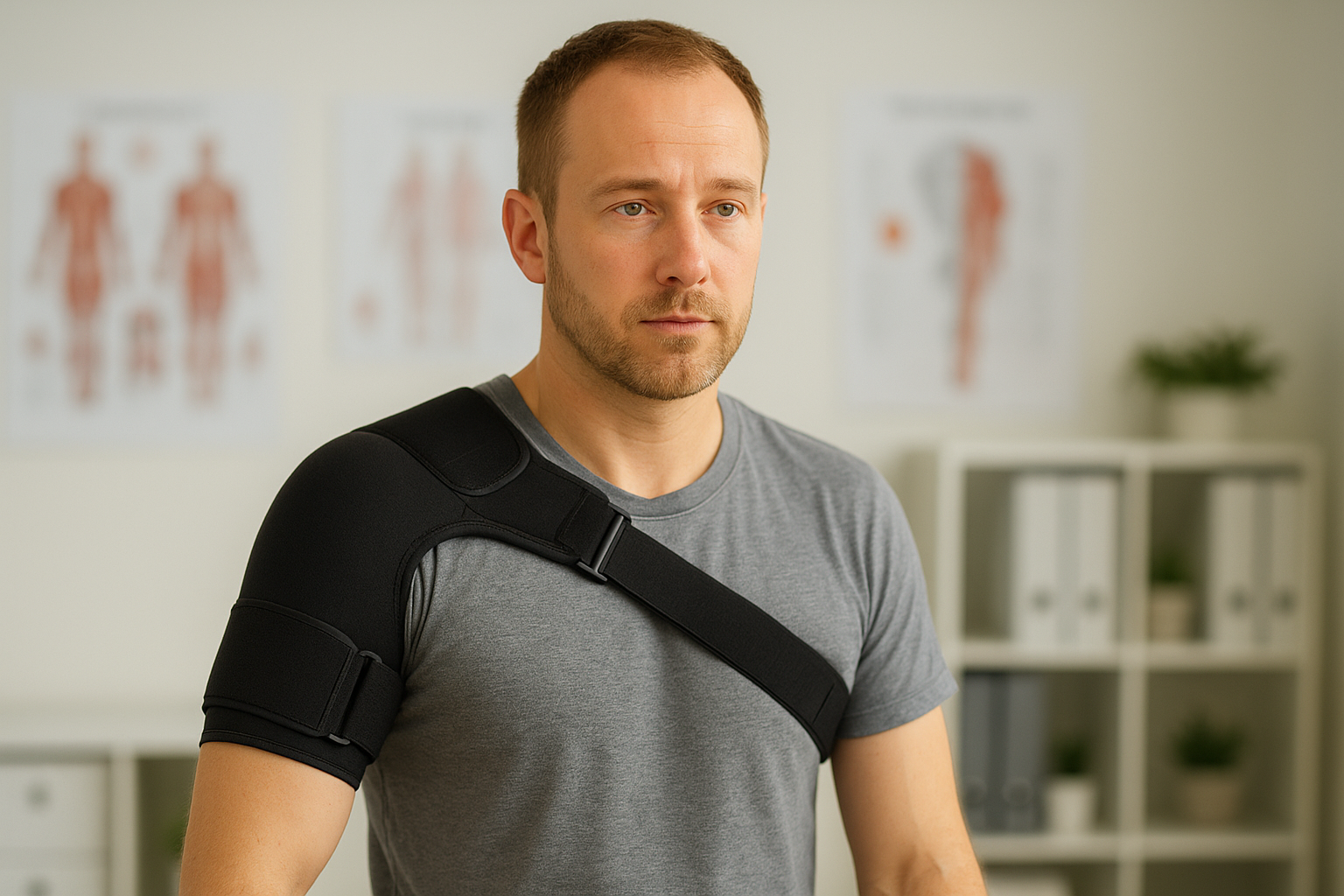Shoulder pain or instability can make even simple movements like lifting your arm or reaching overhead feel uncomfortable. That’s where a shoulder brace comes in. Designed to support, stabilise, and protect the shoulder joint, this medical accessory is commonly used during recovery, injury prevention, or post-surgery rehabilitation.
But what exactly is a shoulder brace used for, and how can it help improve comfort and mobility? In this article, we’ll explore the different purposes and benefits of wearing a shoulder brace, the situations in which it’s most effective, and how it plays a key role in restoring strength and confidence in your shoulder.
How does a shoulder brace work?
A shoulder brace is a medical support device designed to stabilise, protect, and relieve the shoulder joint. Whether used for recovery after an injury, post-surgery rehabilitation, or to prevent strain during physical activity, it plays a crucial role in improving shoulder function and promoting healing. But to understand how it truly helps, it’s important to explore how a shoulder brace works and why it’s so effective in restoring mobility and reducing pain.
Provides stability and prevents excessive movement
The shoulder joint is one of the most mobile and therefore most vulnerable joints in the body. It allows a wide range of motion, from lifting and rotating to reaching and throwing. However, this flexibility comes at the cost of stability. When the ligaments or muscles surrounding the joint are weakened or injured, the shoulder can easily move out of place or become strained.
A shoulder brace works by limiting excessive or harmful movements that could worsen the injury. It gently holds the shoulder in a secure position, preventing dislocation, overextension, or sudden rotation. This controlled restriction allows the surrounding tissues muscles, tendons, and ligaments to heal properly without being overstressed.
By stabilising the joint, the brace also helps restore natural alignment. It keeps the shoulder in an optimal position to reduce strain on weakened areas and promote more efficient recovery.
Supports muscles and relieves tension
When a shoulder is injured or fatigued, the surrounding muscles often compensate, leading to overuse and tension. A shoulder brace helps by redistributing the load across the upper body and giving the shoulder muscles much-needed support.
The gentle compression provided by the brace improves proprioception the body’s awareness of joint position which helps maintain better posture and movement control. This feedback prevents unintentional overuse or awkward motion that could aggravate pain.
By supporting the deltoid, rotator cuff, and upper back muscles, the brace reduces tension and allows the muscles to relax while still maintaining enough movement for comfort and function.
Reduces pain and inflammation through compression
Another key mechanism of a shoulder brace is targeted compression. The snug fit of the brace improves blood flow and circulation around the injured or strained area, which helps reduce inflammation and swelling.
Compression also limits the accumulation of excess fluid in the tissues (known as oedema), a common source of discomfort after injuries or surgeries. By keeping the shoulder warm and supported, the brace helps the body’s natural healing processes work more efficiently.
Additionally, compression stimulates the nerves and sensory receptors in the area, which can help dampen pain signals sent to the brain. This makes the brace not only a mechanical support tool but also a practical aid for pain management.
Encourages proper posture and shoulder alignment
Poor posture is one of the most common causes of shoulder discomfort. Spending hours hunched over a computer or phone can cause the shoulders to roll forward, tightening chest muscles while weakening the upper back. Over time, this imbalance leads to chronic pain and limited range of motion.
A shoulder brace gently pulls the shoulders back, helping realign the spine and promote a neutral posture. This reduces tension in the neck and upper back while encouraging healthier shoulder mechanics. By maintaining correct alignment, it prevents repetitive strain injuries and helps improve overall posture habits even when the brace is not worn.
Aids recovery and builds confidence
Beyond its physical effects, a shoulder brace offers psychological reassurance. People recovering from shoulder injuries often hesitate to move freely out of fear of pain or re-injury. The brace provides a sense of security, allowing them to perform daily tasks and rehabilitation exercises with confidence.
This improved confidence leads to better recovery outcomes. When patients are less afraid of movement, they’re more likely to engage in physiotherapy and gentle activity, which are essential for restoring strength and flexibility.
Adaptable to different needs and conditions
Shoulder braces are designed in various styles to meet specific needs. Some are made for sports use, offering lightweight, breathable support during training or competition. Others are designed for medical rehabilitation, providing firmer stabilisation after surgery or dislocation.
No matter the type, the principle remains the same: a shoulder brace works by combining stabilisation, compression, and posture correction to protect the joint while allowing safe mobility.
What are the main benefits of wearing a shoulder brace?
A shoulder brace is one of the most effective and non-invasive ways to support your shoulder joint whether you’re recovering from an injury, managing chronic pain, or seeking extra stability during physical activity. By combining compression, stabilisation, and posture correction, it helps reduce strain, ease pain, and promote faster healing.
Wearing a shoulder brace doesn’t just limit movement; it helps your body heal naturally while restoring strength and confidence. Designed to adapt to different needs, from sports injuries to rehabilitation, it provides both physical and psychological support. Here are the main benefits of wearing a shoulder brace and how it can make a difference in your daily life:
-
Stabilises the shoulder joint:
The brace keeps the shoulder properly aligned and prevents excessive or harmful movements that could worsen an injury. This stability helps protect the ligaments and tendons while promoting safe mobility. -
Reduces pain and inflammation:
Gentle compression improves blood flow and decreases swelling, helping to relieve pain caused by injuries, overuse, or inflammation. It also provides warmth, which soothes stiff or tense muscles. -
Supports recovery after injury or surgery:
A shoulder brace gives the muscles and tendons time to heal by limiting strain during the recovery process. It’s often recommended for people recovering from dislocation, rotator cuff tears, or shoulder surgery. -
Improves posture and shoulder alignment:
By pulling the shoulders slightly back, the brace encourages better posture and prevents slouching. This reduces tension in the neck and upper back, helping to prevent chronic pain and muscle imbalance. -
Enhances muscle performance and reduces fatigue:
By supporting weakened muscles, the brace distributes pressure evenly across the shoulder and upper back. This helps prevent overuse and fatigue, especially during sports or repetitive movements. -
Boosts confidence during movement:
Knowing your shoulder is supported allows you to move more freely without fear of re-injury. This psychological reassurance is key to regaining mobility and independence.
In summary, wearing a shoulder brace provides a combination of stability, comfort, and recovery support. It not only protects the joint but also encourages proper posture and confidence essential for healing and long-term shoulder health.
FAQ
What is the main purpose of a shoulder brace?
A shoulder brace is designed to support, stabilise, and protect the shoulder joint. It limits excessive movement, reduces pain, and promotes healing after injury, surgery, or overuse.
Can a shoulder brace help with shoulder pain?
Yes, a shoulder brace helps relieve pain and inflammation by providing gentle compression and keeping the shoulder properly aligned. It’s effective for conditions such as tendonitis, rotator cuff injuries, or arthritis.
When should you wear a shoulder brace?
You should wear a shoulder brace after an injury, during recovery, or when performing repetitive motions that strain the shoulder — such as sports, lifting, or long hours at a desk.
Does a shoulder brace improve posture?
Absolutely. Many shoulder braces are designed to pull the shoulders back slightly, helping correct slouching and improve posture. This reduces tension in the neck and upper back.
Can I wear a shoulder brace during sports or physical activity?
Yes. Lightweight and flexible braces can be worn during activities like tennis, weightlifting, or swimming to prevent strain and stabilise the joint during movement.
Is a shoulder brace suitable for post-surgery recovery?
Definitely. Doctors often recommend wearing a shoulder brace after surgery or dislocation to immobilise the joint and allow ligaments, muscles, and tendons to heal properly.
How long should you wear a shoulder brace each day?
It depends on your condition. In general, 15 to 30 minutes a few times a day can help with posture correction, while longer use may be needed for injury recovery under medical advice.
Can anyone use a shoulder brace?
Most people can use a shoulder brace safely. However, if you have circulation issues, recent fractures, or skin irritation, consult a healthcare professional before using one.



What are the disadvantages of an EMS foot massager?
How long to wear a shoulder brace?